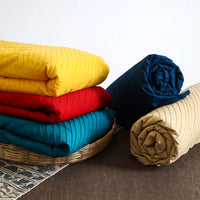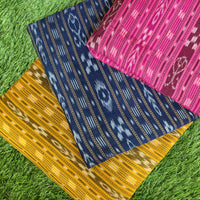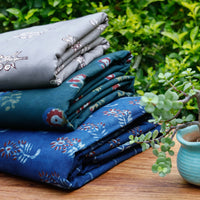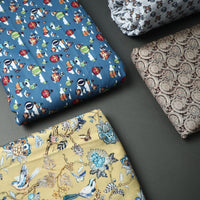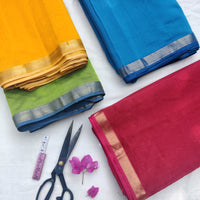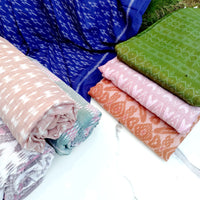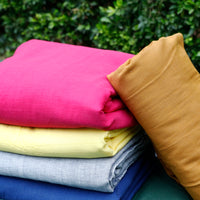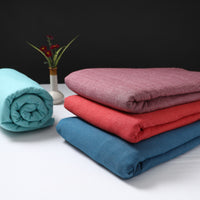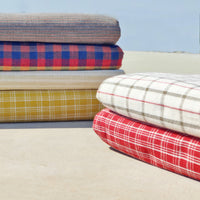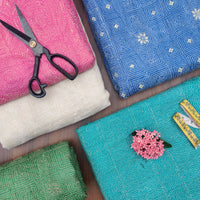Kantha Fabric: A Legacy of Handcrafted Artistry
Kantha fabric is more than just a textile; it’s a manifestation of centuries-old craftsmanship rooted in the cultural traditions of Bengal. This intricate embroidery technique, characterized by its simple yet evocative running stitch, originated as a way for rural women to repurpose old saris and dhotis into layered quilts. Over time, Kantha evolved into a celebrated form of art, where every stitch tells a story—whether it’s a depiction of daily life, a symbolic motif, or a narrative passed down through generations.
The Historical Roots of Kantha Work
Ka...
Kantha Fabric: A Legacy of Handcrafted Artistry
Kantha fabric is more than just a textile; it’s a manifestation of centuries-old craftsmanship rooted in the cultural traditions of Bengal. This intricate embroidery technique, characterized by its simple yet evocative running stitch, originated as a way for rural women to repurpose old saris and dhotis into layered quilts. Over time, Kantha evolved into a celebrated form of art, where every stitch tells a story—whether it’s a depiction of daily life, a symbolic motif, or a narrative passed down through generations.
The Historical Roots of Kantha Work
Kantha’s origins are deeply intertwined with the history and culture of West Bengal and Bangladesh. Historically, it began as a humble practice—women would gather to stitch discarded fabrics together, creating quilts known as "Kanthas." These quilts were often used for domestic purposes, like blankets or covers, but they were imbued with personal significance, as each piece was crafted with care and reflected the maker’s life experiences.
The motifs used in Kantha work are often symbolic—trees of life, animals, and geometric patterns that carry deep cultural meanings. Each region within Bengal has its own distinct style, contributing to the diversity and richness of Kantha embroidery. This makes Kantha not just a craft, but a living tradition that continues to thrive, adapting to contemporary aesthetics while preserving its historical roots.
Kantha Fabric in Contemporary Fashion and Decor
Today, Kantha fabric has transcended its traditional uses and has become a sought-after material in both fashion and home décor. Its versatility allows it to be used in various forms—whether as a vibrant sari, a chic scarf, or a stunning throw. Designers around the world have embraced Kantha for its unique textures and patterns, incorporating it into modern designs that still honor its traditional essence.
Kantha’s appeal lies in its authenticity. The fabric is hand-stitched by skilled artisans, primarily women, who inherit this craft from their mothers and grandmothers. Each piece of Kantha fabric is unique, reflecting the individual artisan’s creativity and the cultural narratives of her community. This makes Kantha a sustainable choice for those who value slow fashion and the preservation of traditional crafts.
The Artisan’s Journey: Preserving Kantha’s Heritage
Behind every piece of Kantha fabric is an artisan whose skill and dedication keep this ancient craft alive. These artisans, predominantly women from rural Bengal, work painstakingly to create intricate designs that are both beautiful and meaningful. Their work is a testament to the resilience and creativity of these communities, who have preserved this craft despite the challenges of modernization and economic pressures.
Platforms like iTokri play a crucial role in supporting these artisans by providing them with access to a global market. By purchasing Kantha fabric from iTokri, you are not just buying a product; you are supporting a sustainable livelihood for these artisans and helping to preserve a cultural heritage that is at risk of disappearing.
Why Choose Kantha Fabric from iTokri?
Authenticity and Quality: Each piece of Kantha fabric at iTokri is carefully selected to ensure it meets the highest standards of craftsmanship. The fabric is sourced directly from artisans, ensuring that every purchase contributes to their well-being and the continuation of this traditional art form.
Cultural Significance: Kantha fabric embodies the rich cultural heritage of Bengal, making it a meaningful addition to your wardrobe or home. Whether you are looking for a unique piece of clothing or a decorative item that tells a story, Kantha offers a connection to a timeless tradition.
Sustainability: Kantha’s origins in repurposing and sustainability align with contemporary values of eco-friendly fashion. By choosing Kantha fabric, you are making a conscious choice to support sustainable practices and reduce waste.
Conclusion: Embrace the Heritage of Kantha
Kantha fabric is a living tradition that carries the weight of history, culture, and personal narratives. Each stitch is a link to the past, a story waiting to be told. By choosing Kantha, you are not only adding a beautiful piece to your collection but also participating in the preservation of an ancient craft.
Explore our collection of Kantha fabrics at iTokri and bring home a piece of India’s cultural heritage. Each purchase supports the artisans who keep this tradition alive and ensures that Kantha remains a vibrant part of our shared cultural legacy.
कांथा फैब्रिक: हस्तनिर्मित कला की एक धरोहर
कांथा फैब्रिक केवल एक वस्त्र नहीं है; यह बंगाल की सांस्कृतिक परंपराओं में जड़ें जमाए हुए सदियों पुराने शिल्प कौशल का प्रतीक है। यह जटिल कढ़ाई तकनीक, जो सरल लेकिन प्रभावशाली रनिंग स्टिच द्वारा पहचानी जाती है, ग्रामीण महिलाओं द्वारा पुराने साड़ियों और धोती को परतों में बदलने के तरीके के रूप में उत्पन्न हुई। समय के साथ, कांथा एक प्रशंसित कला के रूप में विकसित हुई, जहाँ प्रत्येक सिलाई एक कहानी कहती है—चाहे वह दैनिक जीवन का चित्रण हो, एक प्रतीकात्मक चित्रण हो, या पीढ़ियों से चले आ रहे किसी कहानी का हिस्सा हो।
कांथा की जड़ें पश्चिम बंगाल और बांग्लादेश के इतिहास और संस्कृति में गहराई से जुड़ी हुई हैं। यह एक साधारण प्रथा के रूप में शुरू हुआ था, जहाँ महिलाएं एकत्र होकर पुराने कपड़ों को सिलती थीं और उन्हें "कांथा" के रूप में जानी जाने वाली रजाईयों में बदल देती थीं। इन रजाईयों का उपयोग घरेलू उद्देश्यों के लिए किया जाता था, लेकिन वे व्यक्तिगत महत्व से भरी होती थीं, क्योंकि प्रत्येक टुकड़ा देखभाल के साथ तैयार किया जाता था और इसके निर्माता के जीवन के अनुभवों को प्रतिबिंबित करता था।
आज, कांथा फैब्रिक ने अपने पारंपरिक उपयोगों को पार कर लिया है और फैशन और होम डेकोर में एक लोकप्रिय सामग्री बन गई है। यह फैब्रिक अपनी प्रामाणिकता के लिए पहचानी जाती है, जो कुशल कारीगरों, मुख्य रूप से महिलाओं द्वारा हस्तनिर्मित होती है। प्रत्येक कांथा फैब्रिक का टुकड़ा अद्वितीय होता है, जो कारीगर की रचनात्मकता और उसकी समुदाय की सांस्कृतिक कथाओं को दर्शाता है।
iTokri जैसे प्लेटफार्म इन कारीगरों का समर्थन करने में महत्वपूर्ण भूमिका निभाते हैं, उन्हें वैश्विक बाजार में पहुंच प्रदान करते हैं। iTokri से कांथा फैब्रिक खरीदने पर, आप न केवल एक उत्पाद खरीद रहे हैं, बल्कि उन कारीगरों की आजीविका को भी समर्थन दे रहे हैं और एक सांस्कृतिक धरोहर को संरक्षित करने में मदद कर रहे हैं।
कांथा फैब्रिक की देखभाल में इसे ठंडे पानी से हाथ से धोना, छाया में सुखाना, और कम तापमान पर उल्टी तरफ से आयरन करना शामिल है। यह कपड़ा प्रामाणिक, टिकाऊ और सांस्कृतिक रूप से समृद्ध है, और इसे चुनकर आप एक प्राचीन शिल्प को संरक्षित करने में योगदान दे रहे हैं।

















